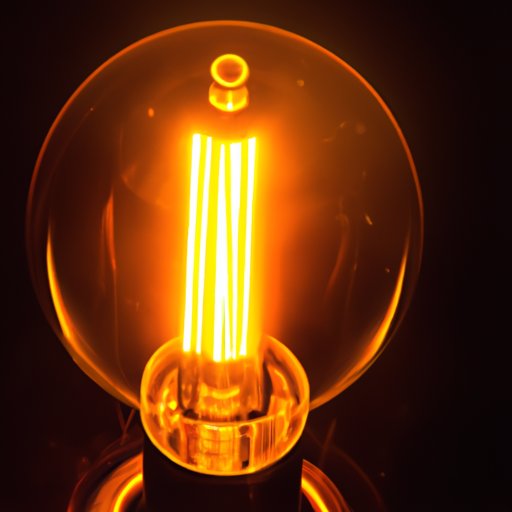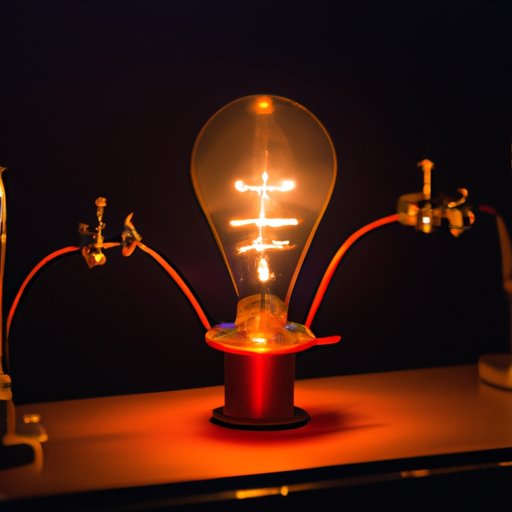Introduction
The electric light is an integral part of modern life. It illuminates our homes, workplaces, and public spaces, giving us the ability to work and play into the night. But have you ever stopped to consider how this technology came to be? This article takes a look at the history of the electric light, exploring the milestones in its invention and examining the pathway that made the invention possible.
Definition of Electric Light
The electric light is a device that produces light through the use of electricity. It consists of a lamp, which is connected to a power source, such as a battery or generator. The lamp contains a filament, which emits light when heated by an electrical current. Modern electric lights are commonly called “light bulbs,” although they can also be referred to as “lamps” or “globes.”
A Historical Look at the Invention of the Electric Light
The history of the electric light is a long and complex one. In the late 1700s, scientists began experimenting with electricity and its potential for producing light. These early experiments were limited in scope and success, but they laid the groundwork for more ambitious attempts at electric illumination.
Early Attempts at Electric Illumination
The first recorded attempt at electric lighting was made by Humphry Davy in 1802. He created an arc light by passing an electrical current between two charcoal sticks. The resulting light was bright, but it was too intense for practical purposes. Subsequent attempts to create an electric light focused on using a vacuum tube, similar to a lightbulb, as a source of illumination.
The Rise of Gas Lighting
In the mid-1800s, gas lighting became increasingly popular, providing a cheaper and more reliable source of illumination than oil lamps. With gas lighting, a flame is ignited inside a glass globe, creating a bright, steady light. This method remained the dominant form of lighting until the invention of the electric light.
Exploring the Concept of Electricity
At the same time, scientists were continuing to explore the concept of electricity and its potential for producing light. One of these scientists was Joseph Swan, who began experimenting with incandescent light bulbs in the 1860s. Swan’s experiments led to the development of an efficient electric light bulb, paving the way for the invention of the electric light.

Exploring the Milestones of the Electric Light Revolution
The invention of the electric light was a gradual process, with several key milestones along the way. Let’s take a closer look at some of these milestones.
Joseph Swan’s Experiments with Light Bulbs
In the 1860s, Joseph Swan began experimenting with incandescent light bulbs. He developed a carbon filament that could be heated by an electric current, producing a steady, bright light. Swan was able to demonstrate his invention in 1878, and he received a patent for his light bulb in 1880.
Thomas Edison’s Development of the Incandescent Light Bulb
In 1879, Thomas Edison began working on the development of an incandescent light bulb. He improved on Swan’s design, creating a bulb that was smaller, brighter, and more efficient. After several years of research and experimentation, Edison was able to demonstrate a working model of his light bulb in December 1879.
The Introduction of the First Commercial Electric Light
In 1882, the world’s first commercial electric light was installed in a London office building. The light was powered by a generator located in the basement, and it provided a steady, bright light for the building’s occupants. This event marked the beginning of the electric light revolution.

Meet Joseph Swan: The Man Behind the Electric Light
Joseph Swan was a British scientist and inventor who is credited with inventing the first practical incandescent light bulb. Swan was born in Sunderland, England in 1828. He studied chemistry at Durham University, and he went on to become a Professor of Chemistry at Newcastle College.
Biographical Overview of Swan
Swan was a prolific inventor and entrepreneur. He held more than 50 patents, including patents for a range of inventions related to photography, printing, and electric lighting. He also founded the Swan Electric Light Company in 1883, which would later become part of the Edison & Swan United Electric Company.
His Contributions to the Development of the Electric Light
Swan’s most important contribution was the development of the incandescent light bulb. His invention used a carbon filament that could be heated by an electric current, producing a steady, bright light. Swan’s experiments paved the way for the development of the modern electric light, and his legacy lives on today.
How Edison’s Invention Changed the Course of History
Edison’s invention of the incandescent light bulb had far-reaching implications for society. It changed the way people lived and worked, and it revolutionized the industrial and entertainment industries.
The Impact of the Electric Light on Industry
The electric light had a profound impact on industry. Factories and other industrial facilities could now operate around the clock, increasing production and profits. According to a study conducted by the National Bureau of Economic Research, the introduction of the electric light led to a 15% increase in factory output over the course of 10 years.
The Influence of the Electric Light on Pop Culture
The electric light also had a major influence on pop culture. It allowed theaters, concert halls, and other venues to remain open into the night, allowing people to enjoy live performances into the wee hours of the morning. As a result, nightlife flourished in cities across the world, ushering in a new era of entertainment and leisure.
The Impact of the Electric Light on Modern Society
Today, the electric light is an essential part of modern life. It has many benefits, including improved safety and efficiency, but it also poses certain challenges.
Benefits of Electric Lighting
Electric lighting provides a number of benefits. It is safer than gas lighting, as it does not produce toxic fumes or require open flames. It is also more energy-efficient than traditional lighting methods, reducing energy costs and emissions.
Challenges Posed by Electric Lighting
Electric lighting also poses certain challenges. For example, it produces light pollution, which can disrupt ecosystems and interfere with astronomical observations. Additionally, electric lighting requires a reliable power source, which is not always available in remote locations.

Examining the Pathway to the Invention of the Electric Light
The invention of the electric light required a combination of technological advances, research, and ingenuity. Let’s take a look at some of the factors that made the invention possible.
Technology Advancements That Made the Invention Possible
The invention of the electric light was made possible by several key technological advancements. These included the development of the electric generator, which allowed electricity to be generated on a large scale, and the discovery of the carbon filament, which enabled electric lights to produce a steady, bright light. Without these advances, the invention of the electric light would not have been possible.
The Role of Research in Driving Innovation
Research was also an important factor in the invention of the electric light. Scientists like Joseph Swan and Thomas Edison dedicated themselves to understanding and improving upon existing technologies, ultimately leading to the development of the modern electric light.
Conclusion
The invention of the electric light was a turning point in human history. It revolutionized industry, changed the way people lived and worked, and ushered in a new era of entertainment and leisure. The invention was made possible by a combination of technological advancements, research, and ingenuity. Today, the electric light is an essential part of modern life, and its legacy lives on.
(Note: Is this article not meeting your expectations? Do you have knowledge or insights to share? Unlock new opportunities and expand your reach by joining our authors team. Click Registration to join us and share your expertise with our readers.)
